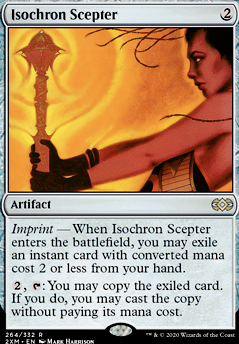
T&T Bloom Scepter [cEDH Primer]
Commander / EDH Combo Competitive Control Counterspell GWUB Land Destruction Lands Partner Tap/Untap
Instant (Interaction) (18)
- 1x Pact of Negation
- 1x Chain of Vapor
- 1x Dispel
-
1x
Flusterstorm

- 1x Mental Misstep
- 1x Nature's Claim
- 1x Swan Song
- 1x Veil of Summer
- 1x Abrupt Decay
- 1x Assassin's Trophy
- 1x Counterspell
- 1x Cyclonic Rift
- 1x Dovin's Veto
- 1x Mana Drain
- 1x Muddle the Mixture
- 1x Fierce Guardianship
- 1x Force of Will
Land (Fetch) (9)
- 1x Bloodstained Mire
- 1x Flooded Strand
- 1x Marsh Flats
- 1x Misty Rainforest
- 1x Polluted Delta
- 1x Scalding Tarn
- 1x Verdant Catacombs
- 1x Windswept Heath
- 1x Wooded Foothills
Instant (Tutor/Utility) (6)
- 1x Brainstorm
- 1x Enlightened Tutor
- 1x Mystical Tutor
- 1x Noxious Revival
- 1x Vampiric Tutor
- 1x Narset's Reversal
Creature (Hate/Utility) (5)
Dramatic Scepter Combo (2)
Land (Fetch Targets) (12)
- 1x Bayou
-
1x
Breeding Pool

- 1x Dryad Arbor
-
1x
Hallowed Fountain

- 1x Mystic Sanctuary
- 1x Savannah
- 1x Scrubland
- 1x Tropical Island
- 1x Tundra
- 1x Underground Sea
-
1x
Watery Grave

- 1x Zagoth Triome
Artifact (Rock) (9)
- 1x Chrome Mox
- 1x Lotus Petal
- 1x Mana Crypt
- 1x Mox Amber
- 1x Mox Diamond
- 1x Mox Opal
- 1x Mana Vault
- 1x Sol Ring
- 1x Arcane Signet
Sorcery (Draw/Tutor) (7)
- 1x Gitaxian Probe
- 1x Green Sun's Zenith
- 1x Imperial Seal
- 1x Ponder
- 1x Demonic Tutor
- 1x Timetwister
- 1x Windfall
[Flex] Bloom Combo (6)
- 1x Exploration
- 1x Squandered Resources
- 1x Summer Bloom
- 1x Crucible of Worlds
- 1x Dryad of the Ilysian Grove
- 1x Ramunap Excavator
Enchantment (Utility) (3)
[Flex] ANAG Combo (2)
Commanders (2)
Land (Utility) (9)
- 1x Boseiju, Who Endures
- 1x Command Tower
- 1x Gemstone Caverns
- 1x Horizon Canopy
- 1x Mana Confluence
- 1x Nurturing Peatland
- 1x Otawara, Soaring City
- 1x Strip Mine
- 1x Waterlogged Grove
Creature (Dork) (5)
Planeswalker (Hate) (3)
[Flex] Smog Apprentice (2)
Maybeboard
Bloom Package (16)
- 1x Gaea's Cradle
- 1x Gingerbread Cabin
- 1x Mystic Sanctuary
- 1x Nurturing Peatland
- 1x Silent Clearing
- 1x Strip Mine
- 1x Waterlogged Grove
- 1x Witch's Cottage
- 1x Burgeoning
- 1x Crop Rotation
- 1x Exploration
- 1x Life from the Loam
- 1x Squandered Resources
- 1x Summer Bloom
- 1x Crucible of Worlds
- 1x Ramunap Excavator
Hate Alternatives (8)
- 1x Grafdigger's Cage
- 1x Pithing Needle
- 1x Collector Ouphe
- 1x Torpor Orb
- 1x Arcane Laboratory
- 1x Hushwing Gryff
- 1x Teferi, Time Raveler
- 1x Karn, the Great Creator
Wheel Package (6)
- 1x Narset, Parter of Veils
- 1x Timetwister
- 1x Windfall
- 1x Alms Collector
- 1x Notion Thief
- 1x Memory Jar
Necropotence Package (4)
Rock Alternatives (4)
Theft Alternatives (3)
Interaction/Removal Alternatives (16)
- 1x Pongify
- 1x Rapid Hybridization
- 1x Stifle
- 1x Countersquall
- 1x Delay
- 1x Drown in the Loch
- 1x Into the Roil
- 1x Narset's Reversal
- 1x Negate
- 1x Tale's End
- 1x Trickbind
- 1x Winds of Abandon
- 1x Winds of Rebuke
- 1x Fierce Guardianship
- 1x Force of Negation
- 1x Toxic Deluge
High Tide Package (7)
-
1x
Godless Shrine

- 1x Island
- 1x Snow-Covered Swamp
- 1x Swamp
- 1x Bubbling Muck
- 1x Candelabra of Tawnos
- 1x High Tide
Dork Alternatives (6)
- 1x Elves of Deep Shadow
- 1x Elvish Mystic
- 1x Fyndhorn Elves
- 1x Gilded Goose
- 1x Llanowar Elves
- 1x Bloom Tender
Inception Package (5)
Tax Alternatives (4)
Land Alternatives (14)
- 1x Arid Mesa
- 1x Bountiful Promenade
- 1x City of Brass
- 1x Exotic Orchard
- 1x Forbidden Orchard
- 1x Indatha Triome
- 1x Morphic Pool
-
1x
Reflecting Pool

- 1x Sea of Clouds
- 1x Snow-Covered Forest
- 1x Snow-Covered Plains
- 1x Tarnished Citadel
- 1x Yavimaya Coast
- 1x Zagoth Triome
Utility Alternatives (10)
- 1x Manifold Key
- 1x Silence
- 1x Utopia Sprawl
- 1x Veil of Summer
- 1x Voltaic Key
- 1x Wild Growth
- 1x Dark Confidant
- 1x Gaea's Blessing
- 1x Memory's Journey
- 1x Riftsweeper
Counterbalance Package (5)
Top Package (5)
- 1x Elixir of Immortality
- 1x Sensei's Divining Top
- 1x Helm of Awakening
- 1x Mystic Forge
- 1x Bolas's Citadel
ANAG Package (3)
Suggestions
Updates Add
Comments
Attention! Complete Comment Tutorial! This annoying message will go away once you do!
Important! Formatting tips — Comment Tutorial — markdown syntax
Please login to comment
Casual
97% Competitive
Revision 25 See all
(2 years ago)
| -1 | Burgeoning | main |
| +1 | Chain of Smog | main |
| -1 | Dark Ritual | main |
| -1 | Takenuma, Abandoned Mire | main |
| +1 | Veil of Summer | main |
| +1 | Witherbloom Apprentice | main |
| Top Ranked |
|
| Date added | 6 years |
| Last updated | 2 years |
| Legality | This deck is not Commander / EDH legal. |
| Rarity (main - side) | 13 - 0 Mythic Rares 57 - 0 Rares 16 - 0 Uncommons 14 - 0 Commons |
| Cards | 100 |
| Avg. CMC | 1.73 |
| Tokens | Bird 2/2 U, Elk 3/3 G, Food |
| Folders | Learning decks, Jeremy would like, Thymna, Commander (Competitive: Tier 1), Sample Decks, Cool decks, AAWant to try, cEDH |
| Votes | |
| Ignored suggestions | |
| Shared with | |
| Views |

